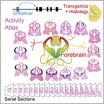(Press-News.org) How does a mountain range maintain its youthful, rugged appearance after 200 million years without tectonic activity? Try a geological facelift – courtesy of the earth's mantle.
Researchers from North Carolina State University noticed that a portion of the Appalachian Mountains in western North Carolina near the Cullasaja River basin was topographically quite different from its surroundings. They found two distinct landscapes in the basin: an upper portion with gentle, rounded hills, where the average distance from valley to mountain top was about 500 feet; and a lower portion where the valley bottom to ridgeline elevation difference was 2,500 feet, hills were steep, and there was an abundance of waterfalls. The researchers believed they could use this unique topography to decipher the more recent geologic history of the region.
The Appalachian mountain range was formed between 325 to 260 million years ago by tectonic activity – when tectonic plates underneath the earth's surface collided and pushed the mountains up. Around 230 million years ago, the Atlantic Ocean basin began to open, and this also affected the regional topography. But geologists knew that there hadn't been any significant tectonic activity in the region since then.
"Conventional wisdom holds that in the absence of tectonic activity, mountainous terrain gets eroded and beveled down, so the terrain isn't as dramatic," says Sean Gallen, NC State graduate student in marine, earth and atmospheric sciences. "When we noticed that this area looked more like younger mountain ranges instead of the older, rounded, rolling topography around it, we wanted to figure out what was going on."
Gallen and Karl Wegmann, an assistant professor of marine, earth and atmospheric sciences at NC State, decided to look at the waterfalls in the area, because they would have formed as the topography changed. By measuring the rate of erosion for the falls they could extrapolate their age, and therefore calculate how long ago this particular region was "rejuvenated" or lifted up. They found that these particular waterfalls were about 8 million years old, which indicated that the landscape must have been raised up around the same time.
But without tectonic activity, how did the uplift occur? Gallen and Wegmann point to the earth's mantle as the most likely culprit. "The earth's outer shell is the crust, but the next layer down – the mantle – is essentially a very viscous fluid," Wegmann says. "When it's warm it can well up, pushing the crust up like a big blister. If a heavy portion of the crust underneath the Appalachians 'broke off,' so to speak, this area floated upward on top of the blister. In this case, our best hypothesis is that mantle dynamics rejuvenated the landscape."
The researchers' findings appear in Geological Society of America Today. Del Bohnenstiehl, NC State associate professor of marine, earth and atmospheric sciences, contributed to the work.
INFORMATION:
Note to editors: Abstract follows.
"Miocene rejuvenation of topographic relief in the southern Appalachians"
Authors: Sean F. Gallen, Karl W. Wegmann, and DelWayne R. Bohnenstiehl, North Carolina State University
Published: Geological Society of America Today
Abstract:
Conventional wisdom holds that the southern Appalachian Mountains have not experienced a significant phase of tectonic forcing for > 200 m.y.; yet, they share many characteristics with tectonically active settings, including locally high topographic relief, steep slopes, incised river gorges and frequent mass-wasting events. Two competing hypotheses are commonly used to explain their modern topographic expression. One suggests that relief is largely controlled by variable lithologic resistance to weathering and that their modern form has long persisted in a dynamic equilibrium. The second postulates that their relief is a product of recent rejuvenation, driven either by climate change or the epeirogenic uplift of the land surface driven by mantle forcing. Within portions of the Cullasaja River Basin of the southern Appalachians, we show that relief has increased by > 150% since the Miocene. Evident within the basin are a set of retreating knickpoints that delineate a rugged actively incising landscape from lower-relief relict topography. Constraints on the timing of knickpoint entry into the basin suggest that the process of landscape rejuvenation began well prior to the late Cenozoic (< 4 m.y.) transition to a more oscillatory (glacial-interglacial) climate regime. Further, the geomorphology of the Cullasaja River basin is difficult to reconcile in the context of a transition to a more erosive climatic regime, but is consistent with an epeirogenically uplifted landscape. Consequently, these observations lend new support to the idea that the rugged topography of the southern Appalachians has developed in response to post-orogenic regional uplift in the Miocene.
Evidence of geological 'facelift' in the Appalachians
2013-02-01
ELSE PRESS RELEASES FROM THIS DATE:
Genome-wide atlas of gene enhancers in the brain online
2013-02-01
Future research into the underlying causes of neurological disorders such as autism, epilepsy and schizophrenia, should greatly benefit from a first-of-its-kind atlas of gene-enhancers in the cerebrum (telencephalon). This new atlas, developed by a team led by researchers with the U.S. Department of Energy (DOE)'s Lawrence Berkeley National Laboratory (Berkeley Lab) is a publicly accessible Web-based collection of data that identifies and locates thousands of gene-regulating elements in a region of the brain that is of critical importance for cognition, motor functions ...
New role for DNA methylation in subset of premature aging disorder patients
2013-02-01
Scientists at the Bellvitge Biomedical Research Institute in Barcelona, Spain have found new evidence for the role of epigenetic changes (those heritable alterations in gene expression caused by mechanisms other than changes in DNA sequence) on premature aging diseases. A new study published in the journal Epigenetics on Jan. 1, 2013, identified a role for DNA methylation changes in a subset of Hutchinson-Gilford Progeria and Werner Syndrome patients, for which no genetic cause (such as DNA mutation) had been associated with onset disease. The study, titled "Aberrant DNA ...
Safe sex practices among African American women
2013-02-01
Los Angeles, CA (January 31, 2013) Researchers have found that African American women exhibit a higher risk for sexually transmitted infections including HIV/Aids. But what motivates this group of women to have sex? And when are they more likely to use protection?
A new study published today in Health Education & Behavior (a SAGE journal) found that regardless of motivations for having sex, condom use expectations were less than 50% for all types of sexual encounters, including the riskiest types of sex.
Researchers Julianna Deardorff et. al used a combination of interviews ...
Men taking long-acting chronic pain meds 5xs more likely to have low testosterone levels
2013-02-01
OAKLAND, Calif., January 31, 2013 — Low testosterone levels occur five times more often among men who take long-acting instead of short-acting opioids for chronic pain, according to a new Kaiser Permanente study published in The Clinical Journal of Pain.
While it has been known that opioids cause low testosterone in men, this study is the first to show a significant difference in risk between short-acting (immediate release) and long-acting opioids.
The 81 men in the retrospective study were between 26 and 79 years old (median age 51) and were seen in the chronic-pain ...
New device traps particulates, kills airborne pathogens
2013-02-01
A new device called a soft x-ray electrostatic precipitator protected immunocompromised mice from airborne pathogenic bacteria, viruses, ultrafine particles, and allergens, according to a paper published online ahead of print in the journal Applied and Environmental Microbiology. This device, known for short as a SXC ESP, is highly versatile, with multiple potential uses, and Washington University is working on licensing the technology.
"Small particles are difficult to remove, and our device overcomes that barrier," says Pratim Biswas of Washington University, St. Louis. ...
Mutant gene responsible for pigeons' head crests
2013-02-01
Scientists have decoded the genetic blueprint of the rock pigeon, unlocking secrets about pigeons' Middle East origins, feral pigeons' kinship with escaped racing birds and how mutations give pigeons traits like feather head crests.
"Birds are a huge part of life on Earth, but we know surprisingly little about their genetics," says Michael Shapiro, one of the study's two principal authors and a biologist at the University of Utah.
In the new study, "we've shown a way forward to find the genetic basis of traits--the molecular mechanisms controlling animal diversity in ...
Just 11 percent of adults, 5 percent of children participate in medical research
2013-02-01
ANN ARBOR, Mich. – Medical research is vital to the advancement of health care, but many medical research studies have too few people who participate. A new study from the University of Michigan takes an in-depth look at public participation in medical research across the United States.
Through a unique, nationally representative survey of 2,150 households in 2011, University of Michigan researchers found that only 11% of adults and 5% of children had ever participated in medical research. The study was published in January in Clinical and Translational Science.
About ...
2-step immunotherapy attacks advanced ovarian cancer
2013-02-01
PHILADELPHIA -- Most ovarian cancer patients are diagnosed with late stage disease that is unresponsive to existing therapies. In a new study, researchers from the Perelman School of Medicine at the University of Pennsylvania School of Medicine show that a two-step personalized immunotherapy treatment — a dendritic cell vaccine using patients' own tumor followed by adoptive T cell therapy — triggers anti-tumor immune responses in these type of patients. Four of the six patients treated in the trial responded to the therapy, the investigators report this month in OncoImmunology. ...
Nurses at forefront of genomics in healthcare
2013-02-01
On April 14, 2003 a map of the human genome was completed, ushering in a new era of genetics in medicine with applications that include genetic testing; newborn screening; susceptibility to diseases such as cancer, cardiovascular disease, or psychiatric conditions; screening, diagnosis and monitoring of disease; and treatment planning. A special Genomics Issue, including an evidence review by researchers from the National Institutes of Health (NIH), published by Wiley in the Journal of Nursing Scholarship on behalf of the Honor Society of Nursing, Sigma Theta Tau International, ...
Virginia Tech adjunct and colleagues refute a study on 'racial bias' report in NIH awards
2013-02-01
In a recent article in the Chronicle of Higher Education, the National Institutes of Health (NIH) announced it was considering anonymity in the review of grant applications. (Found at: http://chronicle.com/article/NIH-Considers-Anonymity-for/136227/?cid=pm&utm_source=pm&utm_medium=en )
Ge Wang, adjunct professor of biomedical engineering at the Virginia Tech – Wake Forest University School of Biomedical Engineering and Sciences, and seven of his colleagues do not believe this action is necessary if taken to counteract a charge of "racial bias."
For Wang, their study ...



